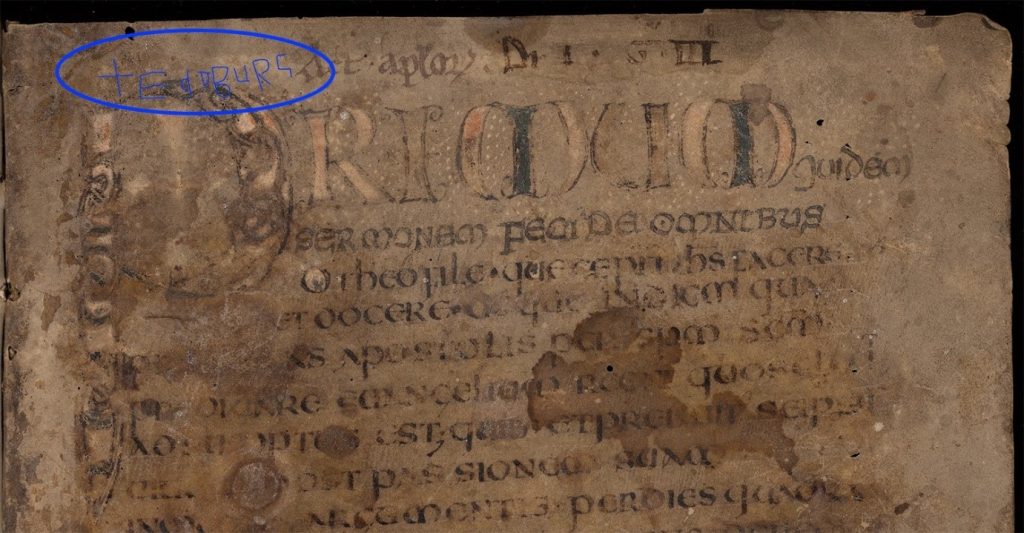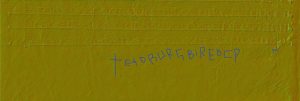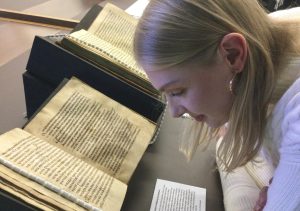Citizen Writes
Research hot topics
Discovery in the margins
2022-12-01
A discovery in the margins: Eadburg and Bodleian Library, MS Selden Supra 30
By Jessica Hodgkinson, PhD Student, University of Leicester
Sitting in the quiet of the Weston Library’s Rare Books and Manuscripts Reading Room, I had to stifle a gasp. Had I just seen what I thought I had? Tiny letters etched into the lower margin of p. 18 of Bodleian Library MS. Selden Supra 30. Did that say Eadburg?
Recordings made using state-of-the-art technology by the Bodleian Libraries’ ARCHiOx project, a partnership with the Factum Foundation funded by the Helen Hamlyn Trust, have now confirmed the presence of this Old English female name on this page as part of a longer inscription. They have also revealed many more exciting inscriptions etched into the parchment of this manuscript.
These additions, hidden in the margins for hundreds of years, have the potential to shed new light on the active participation of women in literate culture and the use of books in the early medieval period.
I was given permission to study MS. Selden Supra 30 as part of my PhD research, funded by the AHRC Midlands4Cities doctoral training partnership, which explores the participation of women in early medieval book culture in Western Europe through the analysis of surviving manuscripts commissioned, copied, owned and/or used by them.
I was interested in MS. Selden Supra 30 because a prayer added to the book shortly after it was finished strongly suggests that it was being used by a woman or by a group of women at the time.
The manuscript’s main text, the New Testament book The Acts of the Apostles in Latin, was copied by two scribes in a style of uncial script which suggests that it was written in southern England, most likely somewhere in the kingdom of Kent, between c. 700 and c. 750 AD. Its script has been compared to other surviving manuscripts known or believed to have been copied in eighth-century Kent, including the Vespasian Psalter (London, British Library, Cotton MS Vespasian A I).
The prayers added to p. 70 of MS. Selden Supra 30, which was originally left blank, were written by a different uncial hand which appears to be roughly contemporary with those of the main text. The first prayer was written from the perspective of a woman, described as God’s unworthy servant (indignam famulam). It may have been added to the manuscript by a female scribe.
In 1935, in the second volume of Codices Latini Antiquiores, Elias Avery Lowe first reported another addition to the manuscript – the letters EADB and +E+ etched into the lower margin of p. 47. Given the manuscript’s apparent links to women, Lowe suggested that these letters were abbreviations of the female name Eadburh.
The newly discovered marginal inscriptions confirm Lowe’s theory. Eadburg’s name, written in full, was etched into the parchment of MS Selden Supra 30 five times on five different pages (pp. 1, 2, 3, 12, and 18). Other abbreviated forms of the name (including E, EAD, and EADB) were also added in the margins of these and other pages 10 more times.
Certain letterforms, particularly the distinctive a, U and G, are common to all the newly identified inscriptions. This suggests that the same scribe may have made all of these additions. If so, it is at least possible that the scribe was Eadburg herself.
Unlike the letters added in the lower margin of p. 47 (which Lowe spotted), which were etched in with a sharp implement (perhaps a knife) and are easy to see, the newly discovered inscriptions are almost invisible to the naked eye. The lines are far shallower, some less than a fifth of the width of a human hair. This indicates that they were made using a different type of implement, most likely a stylus, using a technique known as drypoint.
As they are so small and so shallow, these inscriptions can only be seen clearly in the photometric stereo recordings made by John Barrett for ARCHiOx.
On p. 1, for example, Eadburg’s name, preceded by a cross (+), was etched into the parchment over the top of the enlarged decorated initial P which begins the text.

Bodleian Library MS. Selden Supra 30, p. 1. Recording taken by ARCHiOx; inscription digitally annotated in blue.
The decision to etch the name over the top of the first letter of the text must have been deliberate. It establishes Eadburg’s presence in the book from the outset and connects her name intimately with the biblical text it contains.
In the lower margin of p. 18, Eadburg’s name forms part of a multi-word inscription. Here her name also follows a cross. Some of the letters, especially towards the end of the inscription, are difficult to make out, even with the benefit of the new visualisation techniques.

Recording of the lower margin of p. 18 of MS. Selden Supra 18 made by John Barrett for ARCHiOx and enhanced by Jorge Cano. Inscription digitally annotated in blue.
However, the most recent and clearest recording taken of the inscription, enhanced by Jorge Cano, designer and engineer for Factum Arte and the Factum Foundation, appears to show that, among the visible letters, there is a wynn (Ƿ), the Old English letter for W. This indicates that the inscription was written, not in Latin, but in the Old English vernacular language.
A preliminary reading of the inscription is:
+ EaDBURG BIREð CǷ….N
+ Eadburg bears [cw….n]
Most of the letters in what appears to be the third and final word are unclear, with only CW- at the beginning and -N at the end remaining legible.
One Old English noun that could fill this position is cwærtern, meaning ‘prison’. Interestingly, the inscription is positioned beneath the beginning of the text of Acts 5:18 which describes the imprisonment of the Apostles by the high priest of the Temple and his followers. If cwærtern is the third word in the inscription on p. 18, perhaps Eadburg sought to mirror the text, associating herself with the Apostles in their imprisonment.
Although small in scale, and faint, someone, perhaps Eadburg herself, was evidently keen to preserve her name in the pages of this book to be seen by subsequent readers. Whoever was responsible for these additions, they provide clear evidence of a reader’s interaction with this manuscript and active engagement with the text it contains.
Alongside Eadburg’s name, several small intriguing drypoint drawings have also been discovered. Some are clearly human figures, though further investigation is needed to establish who or what they depict. These drawings were added in the same section of the manuscript as Eadburg’s name. They may have been added by the same person. Indeed, on p. 11, a drawing which appears to depict at least three figures, also contains two letter E’s.
Eadburg’s identity remains a mystery for now, though further analysis of the newly discovered additions may provide further information about who she was and how she was linked to this book.

Jessica Hodgkinson reading the manuscript